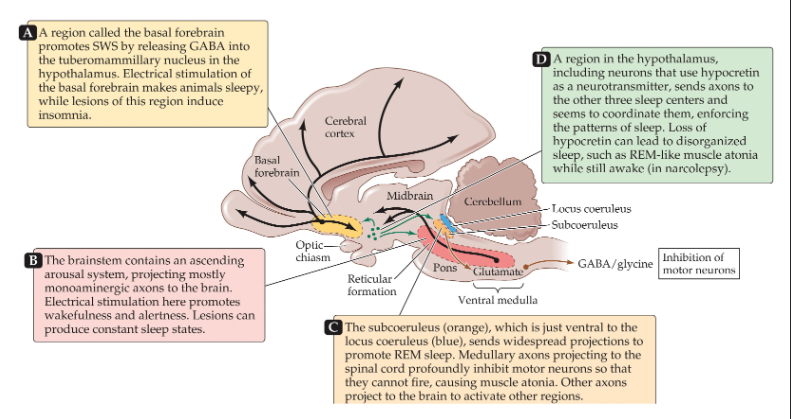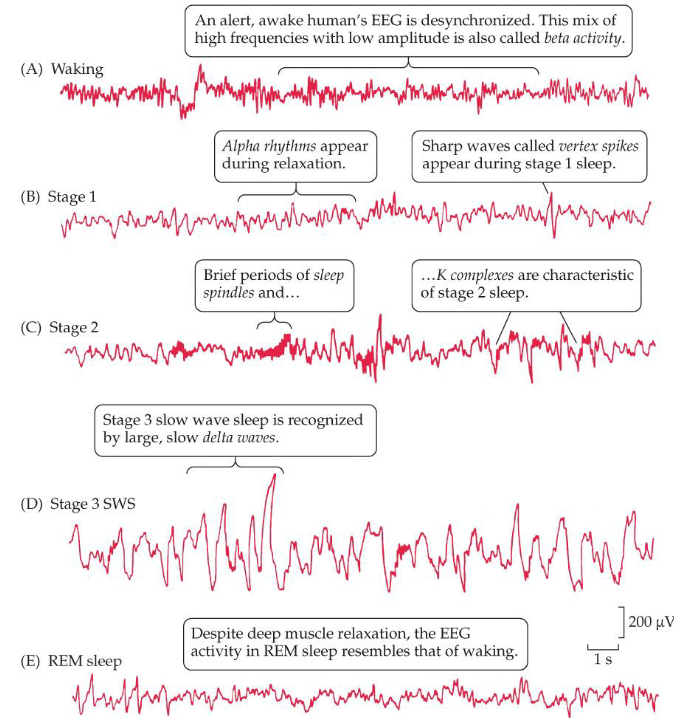Chapter 10: Biological Rhythms & Sleep
1/50
Earn XP
Description and Tags
Made by @agreyr
Name | Mastery | Learn | Test | Matching | Spaced |
|---|
No study sessions yet.
51 Terms
How the brain controls sleep
Forebrain system that generates SWS
Brainstem system that activates the sleeping forebrain to wakefulness (reticular activating system of the brainstem)
Pontine system that triggers REM sleep (REM sleep nuclei in the pons)
Hypothalamic system that coordinates the others

Sleep disorders
Insomnia, hypersomnia, sleep apnea, unreliable respiration, nocturnal myoclonus, narcolepsy, nightmares, night terror, REM behavior disorder, sleep paralysis
Sleep apnea
Unreliable respiration
Nocturnal myoclonus
Restless leg syndrome
Nightmares vs night terror
Nightmares are frightening dreams; night terror is arousal from SWS, intense fear
Narcolepsy
Daytime sleep attacks, cataplexy, sleep hallucinations
REM behavior disorder
Act out a dream while sleeping
Sleep paralysis
Inability to talk/move upon waking or falling asleep
Drugs that affect sleep
Hypnotic drugs and anti-hypnotic drugs
Hypnotic drugs
Benzodiazepines, Ambien, Melatonin
Anti-hypnotic drugs
Stimulants and tricyclic antidepressants
Benzodiazepines
Hypnotic drug
Short-term effects: increase drowsiness, decrease time it takes to fall asleep, reduce number of awakenings, increase total sleep time
Chronic use not recommended; tolerance develops, cessation of use causes insomnia, chronic use causes addiction, they distort the normal pattern of sleep
Ambien
Hypnotic drug
FDA approved for short-term treatment of insomnia; non-benzodiazepine hypnotic but binds to the benzodiazepine site of GABA
Side effects: drowsiness, sleepiness, headache, dizziness, memory impairment, muscle and joint pain
Tolerance, dependance, and withdrawal are possible
Melatonin
Hypnotic drug; a hormone synthesized from serotonin in the pineal gland
Circulating levels of melatonin display circadian rhythms (SCN of the hypothalamus; highest levels associated with darkness and sleep, usefulness is disputable
Stimulants and tricyclic antidepressants
Increase activity of catecholamines by increasing release, blocking reuptake, or both
They act preferentially on REM sleep; can totally suppress REM sleep
Chronic use not recommended; highly addictive, adverse side effects, can interfere with normal sleep
Standard sleep measures
Electroencephalogram (EEG), Electrooculogram (EOG), Electromyogram (EMG)
Electroencephalogram (EEG)
Allows us to look at brain activity through wave patterns
Electrooculogram (EOG)
Analyzing specific muscle movements around the eye (REM vs NREM)
Electromyogram (EMG)
Identifying muscle activity (or lack thereof) in the neck
EEG patterns
Wakefulness, stage 1 sleep EEG, stage 2 sleep EEG, stage 3 sleep EEG

Wakefulness (EEG)
Desynchronized EEG (beta activity)

Stage 1 sleep EEG
Alpha waves and vertex spikes; slowing of the heart rate and relaxation of the muscles

Stage 2 sleep EEG
K complexes and sleep Spindles

Stage 3 sleep EEG
Slow wave sleep; delta waves

REM sleep
Rapid eye movements; loss of core muscle tone (atonia), brainstem regions inhibit motor neurons; low amplitude, high frequency EEG; cerebral activity increases to waking levels; general increase in ANS activity; occasional muscle twitching in extremities; more prominent in later half of sleep cycle
REM and dreaming/dream recall
If you wake people up during REM or NREM sleep, 80% of awakenings from REM sleep but only 7% of awakenings from NREM sleep led to dream recall
Dream interpretation theories
Freudian theory and Hobson’s activation-synthesis theory
Freudian theory of dream interpretation
Dreams represent unacceptable wishes; can determine real desires by understanding the meaning of the dreams we experience
Hobson’s activation-synthesis theory
Information supplied to the cortex during dreaming is largely random and the dream is the cortex attempting to make sense of it; meaning comes from what the people add to the random jumble
Theories on the purpose of sleep
Recuperation theories and adaptation theories
Recuperation theories of sleep
Being awake disrupts homeostasis and sleep is required to restore it
Sleepiness triggered by deviation from homeostasis caused by wakefulness; sleep is terminated by the return to homeostasis
Adaptation theories of sleep
Sleep is the result of an internal timing mechanism
Humans programmed to sleep at night to avoid accidents and predation and to save energy
Purpose of sleep
It fulfills some necessary physiological function; probably not some complex higher order one, as most mammals and birds sleep
Sleep is essential for survival but not necessarily needed in massive quantities
Sleep patterns across the lifespan
Infants sleep a lot, with decreases throughout childhood
REM sleep likely important for nervous system and brain development in infants; high proportions of REM sleep in infants
Increased need for sleep in adolescence
Shift in circadian rhythms for sleep/wake cycles; research shows benefits when these shifts are built into society with later school start times (increased academic performance, fewer driving accidents, and reduced depression rates)
Effects of sleep deprivation in humans
Increase in sleepiness, irritability, difficulty concentrating
Severe sleep deprivation can result in occasional hallucinations
REM rebound (sleep recovery)
You won’t make up for the sleep you lost but you may have more intense sleep for a few days
Sleep functions
Energy conservation, niche adaptation, body & brain restoration, memory consolidation
Energy conservation
Reduced metabolic activity when we sleep
Niche adaptation
Sleep is part of an organism’s ecological niche; emphasizes the role of natural selection
Body & brain restoration
Prolonged deprivation leads to lower immune function; people more susceptible to pain after sleep deprivation
Memory consolidation
Slow wave sleep and REM may plan an important role; synaptic rearrangement occurs during REM
Biological rhythms
Repeating, predictable fluctuations over time; almost all biological functions have a rhythm
Ultradian rhythm
Any biological process that repeats more than once in a day (activity, feeding, some hormone release)
Infradian rhythm
Any biological process that repeats less than once in a day (menstrual cycle, breeding cycle in some animals, seasonal patterns of depression, hibernation)
Circadian (daily) rhythm
Any biological process that cycles through changes in approximately 24 hours (hormone levels, body temp, etc.)
Generated by an endogenous (internal) clock
Adapt to the light-to-dark cycles of the day based on Zeitgebers
Diurnal
Awake during the day, sleep at night (humans & primates)
Nocturnal
Active during dark periods (most other mammals)
Zeitgebers
Environmental cues that control the timing of circadian rhythms
Can be manipulated in laboratory settings; presumed to work via mechanisms in the suprachiasmatic nucleus of the hypothalamus (SCN)
Most obvious one is the circadian sleep-wake cycle
Free-running circadian cycle
In an environment devoid of Zeitgebers, humans and animals still maintain the circadian rhythms, approximately 25 hours in humans; they do not have to be learned
Phase shift
Shift in activity caused by a stimulus (night shift workers)
Entertainment
The process of shifting (jet lag)